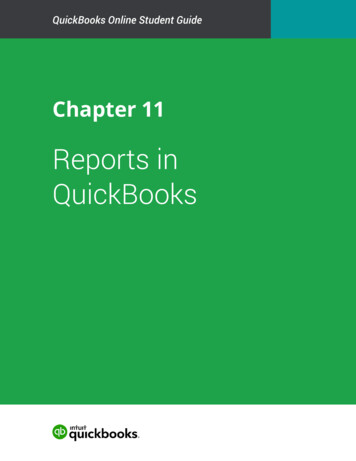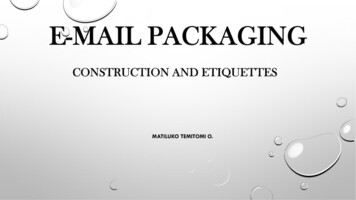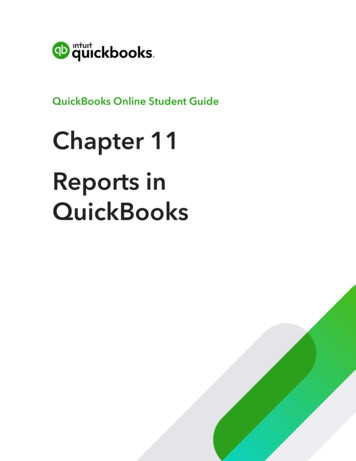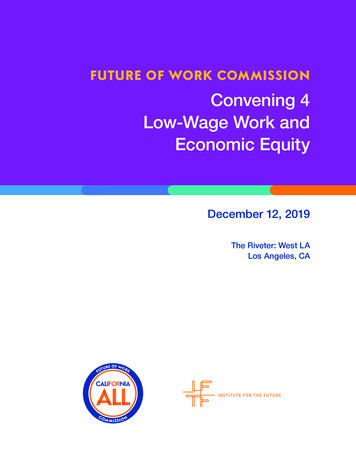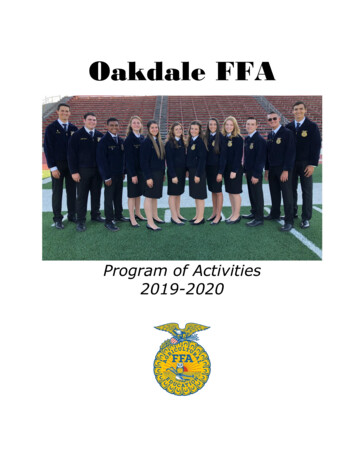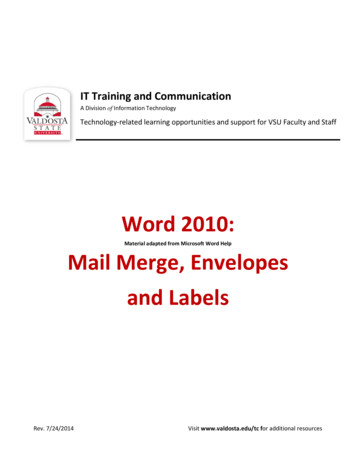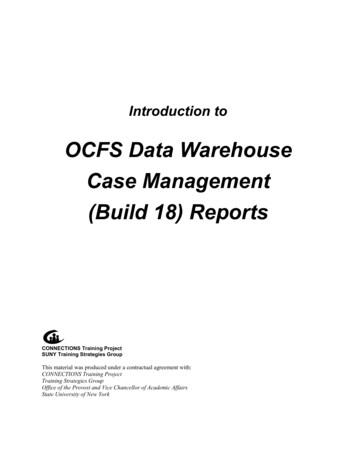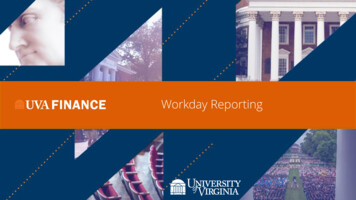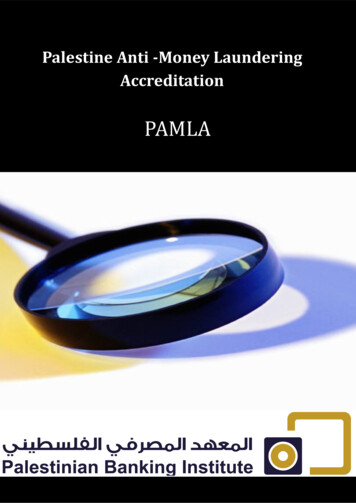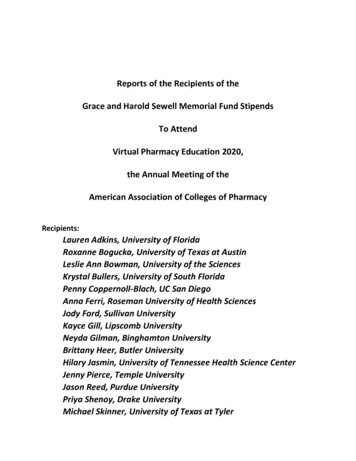
Transcription
Reports of the Recipients of theGrace and Harold Sewell Memorial Fund StipendsTo AttendVirtual Pharmacy Education 2020,the Annual Meeting of theAmerican Association of Colleges of PharmacyRecipients:Lauren Adkins, University of FloridaRoxanne Bogucka, University of Texas at AustinLeslie Ann Bowman, University of the SciencesKrystal Bullers, University of South FloridaPenny Coppernoll-Blach, UC San DiegoAnna Ferri, Roseman University of Health SciencesJody Ford, Sullivan UniversityKayce Gill, Lipscomb UniversityNeyda Gilman, Binghamton UniversityBrittany Heer, Butler UniversityHilary Jasmin, University of Tennessee Health Science CenterJenny Pierce, Temple UniversityJason Reed, Purdue UniversityPriya Shenoy, Drake UniversityMichael Skinner, University of Texas at Tyler
Lauren AdkinsUniversity of FloridaFirst of all, I would like to express my gratitude to the Grace and Harold Sewell Memorial Fundand the Awards Committee of the Library and Information Science Section of the AmericanAssociation of Colleges of Pharmacy for providing this opportunity for AACP attendees to theVirtual AACP Annual Meeting. For the past year I have worked at the University of FloridaHealth Science Center Library as the liaison librarian to the College of Pharmacy and thedepartment of Pharmacology and Therapeutics in the College of Medicine.As a new liaison librarian, it is important to learn about the latest emerging research in the fieldof pharmacy education to better understand my faculty members’ research, education andinstruction needs. I attended “America’s Next Top Scholar: Using Altmetrics to Boost YourImpact Factor” and enjoyed learning about what tools and programs researchers can usedifferent to find out how impactful their research is through altmetrics. These altmetricstatistics can play an important role and provide valuable insight into promotion and tenure,benchmarking productivity, self-promotion, research productivity, and demonstrate the valueof the research outside of the normal benchmarks. I found this session to one of the mostvaluable because several researchers had contacted me to learn about altmetrics and use themeffectively to highlight the impact of their research.In addition to the altmetrics presentation, I enjoyed reviewing the poster, Apples to Oranges:Comparing Citation Counts and Altmetrics across Pharmacy Departments. The research wasinteresting and I think it would be helpful to advocate the importance of including altmetrics intenure and promotion as well as annual evaluations.Overall, this conference provided me with a lot of valuable insight that I hope to bright back tomy institution to further support the faculty and students that I work with. I would like to thankthe Grace and Harold Sewell Memorial Fund and the Awards Committee for this scholarship.2020 Sewell Fund Stipend Recipient Reports, page 1
Roxanne Bogucka,University of Texas at AustinHere are highlights of selected sessions I attended:AMERICA’S NEXT TOP SCHOLAR gave me a helpful way to talk about alt-metrics with faculty.The chart showing metrics at the journal level, author level, and article level was obvious once Isaw it, but I hadn’t thought of framing the conversation that way.The BEYOND BIOSTATS session presented “competencies related to literature analysis,”scaffolded from P1 through P3 years, leading up to P4 journal club presentations, as well asrigorous analyses and presentations on RCTs and helpful rubrics.Standouts among the posters included one on altmetrics that caused me to think about howand where research in the different areas of pharmacy gets cited. I want to re-examine somecitation analysis in preparation for a conversation with faculty. The AMA Citation guide postermade me sit right down and create a Canvas quiz question about parts of a citation, and I hopeto adapt the excellent rubric from the AMA referencing poster.CREATING DISCERNING CLINICIANS: A MODEL FOR LONGITUDINAL LITERATURE EVALUATIONINSTRUCTION discussed guidelines vs evidence. I’d like to reach out to clinical faculty andpreceptors for examples of real-life cases to use in literature evaluation exercises, which thepresenters suggest will help students see the value of engaging with the literature.I’ve attended AACP once before, and I wanted to attend again because of the insideinformation on what faculty see from their students, and how the library in general, and I as theliaison librarian could fit in to pharmacy instruction. I think we librarians always have someideas about what’s needed, but without these sorts of presentations, which are general topharmacy education instead of rooted in our local instructional situations, our ideas run the riskof being overly collections-based. That is to say that we know that Resources X, Y, and Z arevaluable to pharmacy—and they truly are—but we can’t move from teaching students to usetools to providing more fundamental fundamentals, without regularly checking in to see whatpharmacy education’s threshold concepts are.2020 Sewell Fund Stipend Recipient Reports, page 2
Leslie Ann BowmanUniversity of the SciencesVirtual Pharmacy Education 2020 offered a wonderful range of topics. I attended sessionsranging from altmetrics to the history of pharmacy to teaching critical thinking skills. In thisreport, I will discuss only three of the many presentations I attended and enjoyed.Altmetrics offer a view of researchers’ impact on their fields that is not possible with standardmetrics, such as citation indexing. Emily Gorman, Andrew Coop, Hilary Jasmin, Nancy BorjaHart, and Michael Veve presented ‘America's Next Top Scholar: Using Altmetrics to Boost YourImpact Factor’ which suggested ways that faculty can use altmetrics to polish their C.V.s anddossiers. The presentation started me considering how I can introduce altmetrics to pharmacystudents as evidence for the authority of information sources.In ‘Five Hundred Days That Shaped the Future of Pharmacy in the United States’, Gregory Higbydescribed the founding of the Philadelphia College of Pharmacy and of the United StatesPharmacopeia (USP), both of which are about to turn 200 years old. I am a librarian at theUniversity of the Sciences, which began as the Philadelphia College of Pharmacy, so I found thispresentation of special interest. I had not previously appreciated the circumstances of thecollege’s founding and how closely related that was to the founding of the USP.From William Mobley’s ‘Critical Thinking Reflections: Am I Applying the Standards and Virtuesof a Critical Thinker?’, I learned about the basic concepts that make up critical thinking. Thepresentation included an invitation for faculty to reflect on how they use these concepts intheir teaching and how they can purposefully teach pharmacy students to develop their owncritical thinking skills. I hope to use some of these concepts to move my own teaching frominstructing students to use specific information tools to teaching students to explore andevaluate information tools on their own.I am grateful to the Grace and Harold Sewell Fund for my stipend to attend Virtual PharmacyEducation 2020. I also thank the Fund for its continuing support of the Library and InformationScience Section of the American Association of Colleges of Pharmacy.2020 Sewell Fund Stipend Recipient Reports, page 3
Krystal BullersUniversity of South FloridaI was thrilled to receive the Sewell Fund award this year and I appreciated the “flipped” formatthe virtual sessions with live Q&A despite the more frequent incursions from my regular work.Most of the sessions I attended were focused on instruction techniques, particularly relating toinformation literacy topics, such as the LISS-sponsored Creating Discerning Clinicians. Thepresenters from Roseman University discussed how they have developed literature evaluationskills in their students, particularly useful as they operate in a block curriculum which we aremoving to next fall.The other most notable session I attended was The Camera Does Add 10lbs about videoconnected classrooms. I learned so many valuable approaches to increase student engagementand participation. For example, I open the whiteboard in the 15 minutes prior to class posing anicebreaker question. This has become a class favorite!As always, I tried to attend some sessions that were not related to my usual activities, such asthe science plenary and sessions related to IPPEs and APPEs. Some of the presentations andposters were validation of strategies I was already using, such as the AMA Citation Guide.Emily Gorman’s presentation and poster on altmetrics has already come in useful. As a result ofthe session and the follow-on email correspondence, Ms. Gorman shared templates that sheuses that I have been able to modify for new faculty going up for promotion at my school. I amalso curious to see if our departments show any difference between citations from thetraditional literature cites and social media impressions.I am grateful to attend this unique conference and, while I missed the chance to catch up withthe other librarians, I learned a lot that I’ve already been able to put into practice.2020 Sewell Fund Stipend Recipient Reports, page 4
Penny Coppernoll-BlachUC San DiegoI attended 14 sessions during the AACP Virtual Pharmacy Education 2020 conference from July15-31. I had not attended AACP conferences in the past, so I did find that I was not familiarwith some of the acronyms that were being used (like CPS or LIP or CMM as examples).I found all the pre-recorded videos to be of consistently good quality and well edited. I wasable to view all the sessions that were of interest to me and thought that AACP did a good,professional job making sure that all had good audio and slides that looked similar from sessionto session.I did attend the two required session that were sponsored by the LIS programs:1.“America’s Next Top Scholar: Using Altmetrics to Boost Your Impact Fact” – I found thissession to be excellent, with the premise that most researchers should use metrics to increasetheir self-marketing and demonstrate value. Current measurements of research impact are atthe journal level (Journal Impact Factor, Cite Score, or Eigenfactor), the author level (h-index, i10 or G-Index), or the article level (citation tracking, altmetric, Article Influence Score, orPlumX). Altmetrics captures a greater range of scholarly activity, including social media, blogs,and sources such as newspapers or books and can really boost your impact factor. A freebookmarklet is available at Altmetric.com, and a good guide on how to use metrics is athttps://www.metrics-toolkit.org/ .2.“Creating Discerning Clinicians: A Model for Longitudinal Literature EvaluationInstruction” – Literature evaluation is important, but students find it to be boring and do notperceive its value. Many students just want to follow guidelines or “evidence-based medicine.”Students need to learn evaluation skills during their first two years.I also attended the sessions that had topics about teaching pharmacy and drug informationclasses, how students supplement the learning materials provided in their classes, curriculumdesign elements for hybrid and online courses, and important teaching considerations in avideo connected classroom. I also selected sessions that discussed pharmacy student mindsetsand study habits.These are the concepts that I can put into practice when I am designing and teaching my druginformation classes in the future, and I can share these new ideas and practices with my facultymembers.2020 Sewell Fund Stipend Recipient Reports, page 5
Anna FerriRoseman University of Health SciencesThe Grace and Harold Sewell Memorial Fund stipend for Virtual Pharmacy Education 2020offered a superb opportunity for me to enhance my understanding of the state of PharmacyEducation, particularly during a time of adaptation and change. Virtual Pharmacy Education2020 offered me many ideas for developing or improving library service and instructionalopportunities and a chance to enhance my collaboration with Pharmacy faculty at myinstitution. In addition to the sessions highlighted below I attended sessions on IPE and studentsupport for those who are struggling or at risk of burnout, in order to better understand issuesin Pharmacy Education. Some of the highlights included: Opening General Session: A Lawyer's Prescription for Pharmacists' Role in AchievingHealth Equity by Dayna Bowen Matthew. This amazing presentation gave me a greaterappreciation for the social and community challenges that new Pharmacy professionalsare being prepared to engage with. Impact of an American Medical Association Citation Guide on Pharmacy Student CitingPerformance by Rachel Koenig. This poster helped me clarify my own plans fordeveloping an online, asynchronous support for AMA citation practices at myinstitution. America's Next Top Scholar: Using Altmetrics to Boost Your Impact Factor by EmilyGorman, Andy Coop, Hilary Jasmin, and Nancy Borja-Hart. Through this session Ideveloped ideas for working with our new Office of Research, which is helping tocoordinate research efforts and support services across our institution. Creating Discerning Clinicians: A Model for Longitudinal Literature EvaluationInstruction by Surajit Dey, and Evan Williams. This session was presented by facultyfrom my own institution. My attendance at the live chat session resulted in a plan withone of the presenters for a collaborative project to evaluate and enhance libraryresearch support that I had been providing his students on an as-requested basis.2020 Sewell Fund Stipend Recipient Reports, page 6
Jody FordSullivan UniversityI am grateful for the opportunity the Grace and Harold Sewell Memorial Stipend gave me toattend the AACP Virtual Pharmacy Education Conference. This was my first time attending theAnnual Meeting, and I’m sure my experience was very different from previous meetings due toCOVID-19 and meeting virtually. I attended many sessions but especially focused on thosepromoting social justice, equality, and ethics. I think these topics are especially important thisyear. The sessions I attended helped contextualize events happening during and prior to thepandemic.The plenary session “A Lawyer’s Prescription for Pharmacists’ Role in Achieving Health Equity”focused on how pharmacists can ensure their patients have a fair opportunity to be as healthyas possible. The speaker used current events as an example of structural inequality, includingthe disproportionately high COVID-19 illness and mortality rates of African Americans. I will usethe information from this session to emphasize health equity in the library’s informationliteracy sessions and library guides.In “Mental Health First Aid: Increasing Student Pharmacists Preparedness,” the presentersdescribed their experiences in developing and implementing Mental Health First Aid training.They provided an educational framework to demonstrate to students how to respond to apatient’s mental health crisis. Another session I attended, “Disability Diversity,” gave strategiesfor helping learners maximize their educational potential. I plan to recommend these strategiesto faculty and use them to improve library accessibility.The session “First Do No Harm: How to Avoid Common Pitfalls and Address Ethical Challenges inGlobal Health Education,” outlined common ethical dilemmas related to global health. Thissession was helpful because I can now better support pharmacy faculty and students whoresearch this topic as well as introduce it to new students. Attending the AACP annual meetinghas inspired me to further connect with pharmacy students and faculty and to promote healthequity through information literacy, pharmacy school curricula, and relevant library resources.2020 Sewell Fund Stipend Recipient Reports, page 7
Kayce GillLipscomb UniversityAttending AACP this year was unlike any conference I have attended as a librarian. COVID-19played a major role in that experience. One of the primary reasons I enjoy attending AACP isthe opportunity it provides for me to attend an academic conference along with pharmacyfaculty. When I learned about the move to a virtual conference (which I support), I was initiallyconcerned that the virtual environment would hamper developing new relationships withfaculty I had not worked with previously. I am pleased to report that was not the case.One of the popular topics at this meeting was altmetrics and the impact of one’s scholarshipbeyond traditional journal articles. A department chair contacted me after attending onesession on this topic. She wanted to “pick my brain” about altmetrics. I shared what littleinformation I knew about the topic and pointed out several additional conference sessions thataddressed altmetrics, including the America's Next Top Scholar: Using Altmetrics to Boost YourImpact Factor session. As a result of us comparing notes from those sessions, we are startingthis important conversation at our college. Our university started as a teaching institution andhas slowly started adding research as a primary focus area. Attending this year’s annualmeeting helped equip me to have this dialogue with a faculty member who I had not workedwith before now and exposed me to several helpful resources to build a faculty-focusedworkshop on altmetrics. The plan is to start with a faculty workshop in the fall and add studentworkshops in the spring and/or summer.Other sessions I attended that will be beneficial to my work with pharmacy students include theLessons from a Formulary Decision Making and Informatics Activity in a Drug InformaticsCourse, The Little Search Engine that Could: Literature Appraisal and Data Synthesis, andBeyond Biostats: Integrating Literature Analysis and Practical Applications Early and Often. Eachof these sessions offered new ways to think about teaching drug information. I am constantlytrying to find new methods of teaching drug information that will engage the students andmake a lasting impact. I also appreciated the Opening General Session: A Lawyer's Prescriptionfor Pharmacists' Role in Achieving Health Equity. I found Dr. Matthew’s message particularlytimely in light of the global pandemic and civic unrest across America. I think we need toremember that these situations create more stress for our students, and that now, more thanever, we need to educate our students about the importance of mindfulness.2020 Sewell Fund Stipend Recipient Reports, page 8
Neyda GilmanBinghamton UniversityWhile the virtual format of the 2020 AACP Annual Meeting may not have been the first choicefor many, it did have benefits and overall was a great success. The opening keynotepresentation, “A Lawyer's Prescription for Pharmacists' Role in Achieving Health Equity,” wasprobably one of the best presentations I have been to, quite possibly ever. It was a powerfultalk where I learned about how healthcare led a quiet revolution to desegregate in the past andhow pharmacists integrating into the community more than any other healthcare profession inan opportunity for another revolution today. I also learned more about the health effects ofracial biases including the effects of holding on to the stress of racism. Besides the openingsession I watched twenty-nine other sessions and have additional ones I plan on watching at alater date. This is one of the benefits of the virtual format - I’m able to view a lot more sessionsthan I would in person. One of the sessions that ties into my current (pre-COVID) work was the“Make It V-Real: Incorporating Virtual and Augmented Reality Technologies into Pharm.D.Curriculum to Improve Content Delivery and Student Performance” session as we are utilizingVR at the Libraries and have discussed using VR with the pharmacy school. The “America's NextTop Scholar: Using Altmetrics to Boost Your Impact Factor” was also highly interesting as acolleague and I have been working on Altmetrics and had a similar workshop planned for lastMarch. It was interesting, and reassuring, to see this session as we plan for our workshop to berescheduled for this coming Fall. Although not many of the sessions were directly relevant tomy job, almost all of them allowed me to get a better understanding of pharmacy andpharmacy education which allows me to better relate to my pharmacy faculty.2020 Sewell Fund Stipend Recipient Reports, page 9
Brittany HeerButler UniversityI have worked in medical libraries since 2007, but most recently at Butler University as theHealth Sciences Librarian with primary liaison duties to the College of Pharmacy and HealthSciences. I have been eager to attend a pharmacy-focused conference since I started in thisposition in 2019 so as to expand my knowledge of pharmacy-related issues, learn effectivepedagogy and instructional strategies, and identify where my services and skills may be mostimpactful at my home institution.Thanks to the flexible online conference platform, I was able to attend 12 sessions in additionto the 6 LIS poster presentations. I prioritized content that focused on instruction, informationsupport, topics my faculty were interested in, and presentations by my home faculty. I wasparticularly excited about content regarding altmetrics education and promotion, citationinstruction and exercises, best practices for online instruction, and incorporating literatureevaluation across the curriculum. I was struck by how many pharmacy faculty presentersdiscussed collaborations for instruction and research support, but rarely mentioned howthey’ve used librarians in these scenarios. Had these sessions been in person, I would havehighlighted and promoted what we as librarians can do to support their classes and researchprojects.Although this year has not gone as we all had hoped, I am grateful for the opportunity to haveattended the virtual 2020 AACP Conference. I gained greater insight into the issues facing mypharmacy colleagues and have strengthened my instructional skills with new ideas toincorporate into my lesson plans for this upcoming academic year. Thank you to the Grace andHarold Sewell Memorial Fund and the LIS Awards Committee for facilitating my attendance atthis year’s conference. I hope to meet my new AACP colleagues in person at a future meeting!2020 Sewell Fund Stipend Recipient Reports, page 10
Hilary JasminUniversity of Tennessee Health Science CenterWhile untraditional, my experience with the AACP 2020 Virtual Meeting was a very useful andengaging experience. As a new member, it has been very inspiring to be surrounded by otherpharmacy librarians. As a liaison to pharmacy, it can often feel like a silo in my institution as weeach work in our own colleges; so, hearing from librarians experiencing very similar researchtopics and collaboration opportunities is fulfilling.I really enjoyed working with another LIS member and three pharmacists on our panel,“America’s Next Top Scholar: Using Altmetrics to Boost Your Impact Factor”. It was a greatopportunity to speak with folks across the association who are eager for novel ways to illustratetheir research impact, and it helped me connect with other faculty at my institution that I hadnot yet gotten to work with. All of the LIS posters were engaging and offered me fresh ideas tofurther enhance my liaising. I also was fascinated by the science plenary, and I enjoyedexperiencing a dynamic display of research areas.Overall, this was an exciting opportunity to more deeply understand what my faculty arefocusing their scholarship on, and it offered some inspiration on ways I can approach them forfuture collaborations. I hope to reach out soon to some of the faculty at my institution whopresented at the conference and look into ways I can benefit their research. I look forward tofuture conferences where we will get to work together in person! Thanks very much to theAwards Committee for allowing me this opportunity.2020 Sewell Fund Stipend Recipient Reports, page 11
Jenny PierceTemple UniversityAttending the first ever virtual AACP was a wonderful experience. I’m grateful to the Grace andHarold Sewell Memorial Fund and AACP’s LIS section for making it possible.Since this was my first conference, Temple faculty member Anisha Grover, PharmD, BCACP, anactive AACP member, gave me session suggestions. I also connected with faculty memberNicole Sifontis, PharmD, through her posters on students' patient interview techniques and thesocial determinants of health.Regarding the impact of the COVID - 19 pandemic, the organizers did an amazing job ofrethinking the conference. I could view poster videos and leave comments for the authors. Forthe sessions, being able to view the presentation before meeting with the presenters forconversation was great! I enjoyed hearing, not only them, but others talk about the sessionsand their own scholarship. This was the best way for me to network as the virtual conferencemade that difficult.The education on altmetrics was especially interesting to me. The sessions Taking the Reins inDescribing the Impact of Your Educational Scholarship, America's Next Top Scholar: UsingAltmetrics to Boost Your Impact Factor and LIS member Emily Gorman’s poster, Apples toOranges: Comparing Citation Counts and Altmetrics across Pharmacy Departments were great.Learning about impact mapping and storytelling as ways to document the reach of scholarshipwas new to me and something I can share with faculty at Temple.Attending the conference allowed me to explore the profession’s commitment to scholarship,IPE, and health equity. One program, Encouraging Inclusion: Incorporating LGBTQIA Activitiesfor Community and Hospital Pharmacy Throughout Student Pharmacists EducationalExperience, showed me small ways I can incorporate gender diversity in my teaching. I willbring back what I learned in that workshop and elsewhere at AACP, to focus my work onsupporting student scholarship and faculty research.2020 Sewell Fund Stipend Recipient Reports, page 12
Jason ReedPurdue UniversityThis was a very different AACP experience, but still a valuable opportunity to learn more aboutpharmacy education in general and what is happening at Purdue specifically. I want to start bytalking about the amazing Opening Plenary with Dayna Bowen Matthew. AACP could not havepicked a timelier topic, racial, ethnic, and socioeconomic heath disparities in the US or a moreengaging speaker. I don’t see how anyone who listened to this talk could not be moved by herpassion. I made several notes to review my content within all of my instruction to see where Icould improve my coverage of disparities in healthcare. This session set a strong precedent forthe whole conference. I made it a priority to attend every session that included a presenterfrom Purdue as part of my continuing efforts to network with faculty and identify areas forcollaboration and/or integration of library resources and services. The networking was moredifficult with the virtual conference, but attending these sessions has already resulted in a fewemail exchanges on the topics they presented on or ideas for enhancing existing relationships,in particular the lab sessions I teach in the P1 and P2 years. I thoroughly enjoyed the LISprogramming and in particular I want to highlight the America’s Next Top Scholar: UsingAltmetrics to Boost Your Impact Factor. I found this session to be incredibly useful whenthinking about my own tenure submission and thinking about how I could work with thepharmacy faculty in their own promotion and tenure efforts. This session had a great live chatand I was happy to see how many faculty were open to discussing Altmetrics and relatedconcepts such as institutional repositories. The final part of the conference I will mention werethe poster sessions, I always enjoy poster sessions because there is more variety in the topicsdiscussed. I did miss having the chance to talk more in depth with the poster authors, but acouple of ideas really hit home with either what I try to incorporate, modeling with low stakesassessment, or want to try, peer assessment. I want to finish by thanking the LIS AwardsCommittee and The Grace and Harold Sewell Memorial Fund for this opportunity.2020 Sewell Fund Stipend Recipient Reports, page 13
Priya ShenoyDrake UniversityI am grateful to have been given funding from the Grace and Harold Sewell Memorial Fund toattend the 2020 Virtual Pharmacy Education annual meeting, as this is my last year as theSecretary of Knowledge Management for the Library and Information Science (LIS) Section.I appreciated being able to see my colleagues online if not in person this year. LIS provides mewith a sense of community as a specialized librarian teaching in a pharmacy program.I appreciated viewing the LIS posters and getting some ideas for how librarians and druginformation faculty are teaching AMA citations, drug information, and utilizing altmetrics.The session “America’s Next Top Scholar: Using Altmetrics to Boost Your Impact Factor” wasparticularly interesting for the various resources it provided with regards to altmetrics usage inpromotion and tenure portfolios.I especially enjoyed the opening session on “A Lawyer’s Prescription for Pharmacists’ Role inAchieving Health Equity.” I valued the presentation for its content and the detailed datapresented as well as the interwoven personal experiences. I appreciate that during this difficulttime after George Floyd’s death, AACP took the initiative to not only send out a formalstatement, but to address diversity, equity, and inclusion in healthcare in their mainprogramming. Additionally, the session “The Camera Does Add 10lbs and Other ImportantTeaching Considerations in a Video Connected Classroom” was helpful in giving tips for how Ican approach my embedded drug information teaching this fall semester due to COVID-19. Theconcepts or ideas which I found most beneficial were chunki
Roseman University of Health Sciences The Grace and Harold Sewell Memorial Fund stipend for Virtual Pharmacy Education 2020 offered a superb opportunity for me to enhance my understanding of the state of Pharmacy Education, particularly during a time of adaptation and change. Virtual Pharmacy Education


